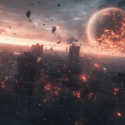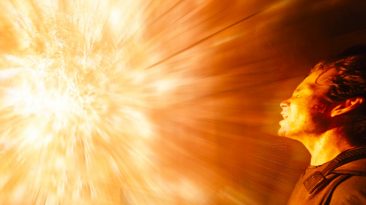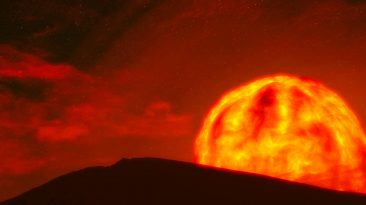A dark, mysterious object has appeared at the outer edges of our Solar System. It looks like the remnants of a dying star. But it behaves like a black hole. Your mission? Traveling right into its heart of darkness. What makes this mysterious object unique? How dangerous would it be to experience such powerful gravity? And how might this turn into one of the strangest experiences in the Universe?
I know we’ve talked about black holes before. But let me do a quick recap. A black hole isn’t much different from any other object with mass. Except it’s really, really dense. All the matter it contains is compressed into one point called a singularity, which is so small and so dense that our understanding of time and space within it breaks down.
That singularity is what causes black holes to have enormous gravity. And then, there are neutron stars. These form when a large star collapses at the end of its stellar life. A star that was once 1.5 times more massive than our own Sun would now only be about 20 km (12 mi) wide. That’s no bigger than a city.
What you have lurking on the outskirts of the Solar System is something else entirely. Too massive to be a neutron star. Too small to be a black hole. This is a black neutron star. Not much is known about these objects. And you’re about to learn it the hard way. For this scenario, let’s ignore the fact that it would take you thousands of years to travel all the way to the outskirts of the Solar System.
Let’s imagine that the best scientists on the planet came up with a way to roam our planetary neighborhood really fast. And now you’d be observing this gravitational monster up close. You’d know exactly where a black neutron star was making its catastrophic approach because of the radiation it emitted. This is the same way that you’d find either a black hole or a neutron star.
Just getting close enough to observe this star won’t be enough. You’d need to venture right into its center. Your mission would require some protective gear. And this gear would need to keep you safe from some of the most intense forces of gravity in the Universe. So don’t take this preparation lightly. This black neutron star would be pulling you toward it with gravity about two billion times stronger than what you’re used to on Earth.
The problem is that the kind of intense gravity protection gear you’d need does not exist. Without it, your mission would be of the suicidal variety. As you’d get closer, different parts of your body would experience different gravity. If you were diving into this monstrosity head-first, your upper body would get stretched a lot more than your legs.
As you got closer to its center, you’d be spaghettified. Yep, you’d become long and thin from your head down to your toes. Just like spaghetti. Only this would be one brutally painful plate of pasta. But since you’d be on an incredibly important mission, you’d have the best equipment you could ever imagine.
The best NASA scientists would supply you with a suit resistant to the extreme pressures, temperatures and radioactive matter inside the black neutron star. Now would be the time for the task at hand. You’d dive layer by layer into an object of incredible mass. It would be like falling into our Sun if it was squeezed into the size of a small city.
On the outside, the black neutron star would look like any other kind of star. Except it would be really toasty. Your regular neutron stars are extremely hot, usually about one million °C (1.8 million °F). A black neutron star? Well, you’d have to find out its temperature on your own. I bet it would be just as scorching.
First, you’d pass through a gaseous layer of hydrogen and helium. After that, you’d find yourself on more solid ground. Scientists think this second layer would likely be composed of iron and silicon. To continue your mission, you’d need to somehow punch through this blazing, solid surface. Lucky for you, NASA equipped you with a super powerful drill that can withstand the heat.
Things would start getting dangerously dense. Hope those guys at NASA made you an extremely durable suit too. Down at the heart of the black neutron star, you’d notice a unique material, one of the strangest in the Universe. Scientists call it nuclear pasta. Inside the neutron star, the nuclear clusters get packed so densely they create the hardest matter ever known.
At least this time it’s not you that’s turned into spaghetti. If all this talk of you being turned into some sort of food item has you worried, brace yourself. The madness would just be getting started. Now you’d be so deep that the intense levels of pressure around you would be about three times higher than the density of an atomic nucleus. Protons and electrons would combine into neutrons.
Hey, now you know how neutron stars got their name. As these newly formed neutrons start to overlap more and more, you’d keep traveling further and further down. Eventually, you’d find yourself face-to-face with the squished components of neutrons and protons. Quarks. Finally approaching the core of the black neutron star, you’d be nearing maximum bizarreness.
Of all the squishy quarks surrounding you, there would be some so weird that even scientists call them ‘strange quarks.’ These quarks are heavier than other quarks and they’ve earned their name by possessing a property known as strangeness. All it means is that strange quarks have less chance of being torn apart by the black neutron star’s electromagnetism.
Inside this core, the strange quarks would form a soupy mixture known simply as strange matter. And encountering strange matter would be the very end of the journey for you. Strange matter is contagious. That means when it comes into contact with ordinary matter, like you, it would generate more strange matter.
So as soon as you’d touch it, it would instantly dissolve your protective gear and immediately after that, your whole body. Maybe it would have been better to avoid all this strangeness and fall into a regular black hole instead.
Sources
- “What If Planet Nine Is A Baby Black Hole?”. Paul Sutter. 2021. livescience.com.
- “What Happens At The Center Of A Black Hole?”. Paul Sutter. 2022. space.com.
- “Neutron Stars: Definition & Facts”. Nola Taylor Tillman, 2018. space.com.
- “Astronomers Find Closest Neutron Star”. 2007. space.com.
- “‘Black Neutron Star’ Discovery Changes Astronomy”. Pallab Ghosh. 2020. bbc.com.



























